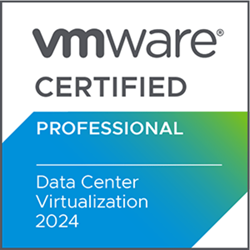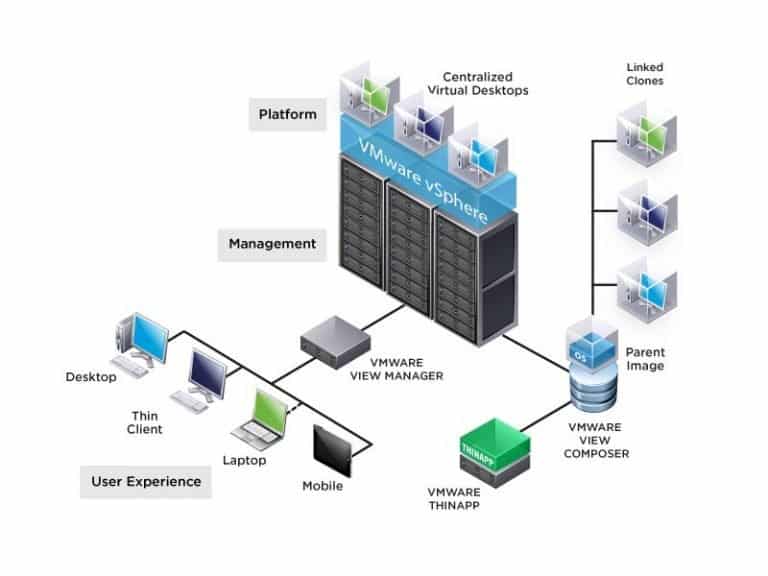VMware vSphere VCP-DCV 2024

The VMware vSphere VCP-DCV 2024 [V8] course is the combination of two VMware vSphere paths: Install, Configure, Manage [V8] and VMware vSphere: Operate, Scale and Secure [V8] , in a single bundle to maximize preparation and minimize costs. The fundamental prerequisite for accessing the VCP-DCV 2024 Certification is participation in an authorized VMware course, combined with the performance of virtualization training laboratories that allow the student to acquire practical experience on VMware vSphere [V8] (ESXi [V8] and vCenter Server [V8]). This path combines several VMware vSphere courses, in a single training path, in a formula that presents continuity, homogeneity and educational effectiveness , compared to a classic formula with separate, fragmented and repetitive courses. The educational effectiveness of this course is also achieved by maximizing the use of the latest generation hands-on laboratories, based on real configuration scenarios and case studies, which increase and train the troubleshooting and problem-solving skills that companies require from VMware VCP-DCV specialists. This is the fundamental course for managing infrastructures based on VMware technologies of Software-defined data centers of any size and oriented to the Cloud . VMware, with its products, is the leading company in virtualization technologies, which today are the fundamental pillars of the IT world and Cloud Computing, allowing the company to reduce energy consumption, company spaces dedicated to IT infrastructures and maintenance and management costs of the same and therefore maximizing IT efficiency. The importance of these technologies derives from a constantly growing demand for IT professionals, experts in the creation, management and configuration of virtualized data centers SDDC (Software Defined Data Center). This course helps prepare for the VMware Certified Professional Data Center Virtualization (VCP-DCV 2024) certification exam.
Course Objectives
Below is a summary of the main objectives of the VMware vSphere VCP-DCV 2024 [V8] Course :
- Installing and configuring ESXi and vCenter.
- Create and manage virtual networks with standard and distributed switches.
- Configure and manage datastores with vSphere-supported storage technologies.
- Using vSphere Client to create virtual machines, templates, clones, and snapshots.
- Configure and manage vSphere clusters for high availability and resource distribution.
- VM resource management with resource pools.
- Advanced network and storage configuration in VMware vSphere.
- Using Host Profiles for VMware ESXi™ 8 Host Compliance.
Course Certification
This course helps you prepare to take the:
VMware Certified Professional Data Center Virtualization Exam (VCP-DCV 2024);
Course Outline
- Course Introduction
- Introductions and course logistics
- Course objectives
- vSphere and Virtualization Overview
- Explain basic virtualization concepts
- Describe how vSphere fits in the software-defined data center and the cloud infrastructure
- Recognize the user interfaces for accessing vSphere
- Explain how vSphere interacts with CPUs, memory, networks, storage, and GPUs
- Installing and Configuring ESXi
- Install an ESXi host
- Recognize ESXi user account best practices
- Configure the ESXi host settings using the DCUI and VMware Host Client
- Deploying and Configuring vCenter
- Recognize ESXi hosts communication with vCenter
- Deploy vCenter Server Appliance
- Configure vCenter settings
- Use the vSphere Client to add and manage license keys
- Create and organize vCenter inventory objects
- Recognize the rules for applying vCenter permissions
- View vCenter logs and events
- Configuring vSphere Networking
- Configure and view standard switch configurations
- Configure and view distributed switch configurations
- Recognize the difference between standard switches and distributed switches
- Explain how to set networking policies on standard and distributed switches
- Configuring vSphere Storage
- Recognize vSphere storage technologies
- Identify types of vSphere datastores
- Describe Fibre Channel components and addressing
- Describe iSCSI components and addressing
- Configure iSCSI storage on ESXi
- Create and manage VMFS datastores
- Configure and manage NFS datastores
- Deploying Virtual Machines
- Create and provision VMs
- Explain the importance of VMware Tools
- Identify the files that make up a VM
- Recognize the components of a VM
- Navigate the vSphere Client and examine VM settings and options
- Modify VMs by dynamically increasing resources
- Create VM templates and deploy VMs from them
- Clone VMs
- Create customization specifications for guest operating systems
- Create local, published, and subscribed content libraries
- Deploy VMs from content libraries
- Manage multiple versions of VM templates in content libraries
- Managing Virtual Machines
- Recognize the types of VM migrations that you can perform within a vCenter instance and across vCenter instances
- Migrate VMs using vSphere vMotion
- Describe the role of Enhanced vMotion Compatibility in migrations
- Migrate VMs using vSphere Storage vMotion
- Take a snapshot of a VM
- Manage, consolidate, and delete snapshots
- Describe CPU and memory concepts in relation to a virtualized environment
- Describe how VMs compete for resources
- Define CPU and memory shares, reservations, and limits
- Deploying and Configuring vSphere Clusters
- Create a vSphere cluster enabled for vSphere DRS and vSphere HA
- View information about a vSphere cluster
- Explain how vSphere DRS determines VM placement on hosts in the cluster
- Recognize use cases for vSphere DRS settings
- Monitor a vSphere DRS cluster
- Describe how vSphere HA responds to various types of failures
- Identify options for configuring network redundancy in a vSphere HA cluster
- Recognize vSphere HA design considerations
- Recognize the use cases for various vSphere HA settings
- Configure a vSphere HA cluster
- Recognize when to use vSphere Fault Tolerance
- Managing the vSphere Lifecycle
- Enable vSphere Lifecycle Manager in a vSphere cluster
- Describe features of the vCenter Update Planner
- Run vCenter upgrade prechecks and interoperability reports
- Recognize features of VMware vSphere® Lifecycle Manager™
- Distinguish between managing hosts using baselines and managing hosts using images
- Describe how to update hosts using baselines
- Describe ESXi images
- Validate ESXi host compliance against a cluster image and update ESXi hosts
- Update ESXi hosts using vSphere Lifecycle Manager
- Describe vSphere Lifecycle Manager automatic recommendations
- Use vSphere Lifecycle Manager to upgrade VMware Tools and VM hardware
- Virtual Machine Operations
- Recognize the role of a VMware ToolsTM Repository
- Configure a VMware Tools Repository
- Recognize the backup and restore solution for VMs
- Identify the components in the VMware vSphere® ReplicationTM architecture
- Deploy and configure vSphere Replication and VMware Site RecoveryTM instances
- Recover replicated VMs
- vSphere Cluster Operations
- Create and manage resource pools in a cluster
- Describe how scalable shares work
- Describe the function of the vCLS
- Recognize operations that might disrupt the healthy functioning of vCLS VMs
- Network Operations
- Configure and manage vSphere distributed switches
- Describe how VMware vSphere® Network I/O Control enhances performance
- Explain distributed switch features such as port mirroring and NetFlow
- Define vSphere Distributed Services Engine
- Describe the use cases and benefits of VMware vSphere® Distributed Services EngineTM
- Storage Operations
- Discuss vSphere support for NVMe and iSER technologies
- Describe the architecture and requirements of vSAN configuration
- Describe storage policy-based management
- Recognize components in the VMware vSphere® Virtual VolumesTM architecture
- Configure Storage I/O Control
- vCenter and ESXi Operations
- Create a vCenter backup schedule
- Recognize the importance of vCenter High Availability
- Explain how vCenter Server High Availability works
- Use host profiles to manage ESXi configuration compliance
- Recognize the benefits of using configuration profiles
- Use the vSphere client and the command line to manage certificates
- vSphere Monitoring
- Monitor the key factors that can affect a virtual machine’s performance
- Describe the factors that influence vCenter performance
- Use vCenter tools to monitor resource use
- Create custom alarms in vCenter
- Describe the benefits and capabilities of VMware SkylineTM
- Recognize uses for VMware Skyline AdvisorTM Pro
- vSphere Security and Access Control
- Recognize strategies for securing vSphere components, such as vCenter, ESXi hosts, and virtual machines
- Describe vSphere support for security standards and protocols
- Describe identity federation and recognize its use cases
- Configure identity federation to allow vCenter to use an external identity provider
- vSphere Trusted Environments and VM Encryption
- Configure ESXi Host Access and Authentication
- Describe virtual machine security features
- Describe the components of a VM encryption architecture
- Create, manage, and migrate encrypted VMs
- List VM encryption events and alarms
- Describe the benefits and use cases of vSphere Trust Authority
Laboratory Activities
- Configuring an ESXi Host
- Creating and Managing the vCenter Inventory Objective
- Adding an Identity Source
- Users Groups and Permissions
- Creating Standard Switches
- Configuring vSphere Distributed Switches
- Accessing iSCSI Storage
- Managing VMFS Datastores
- Accessing NFS Storage Objective
- Creating and Removing a Virtual Machine
- (Simulation) Installing VMware Tools
- Adding Virtual Hardware
- Modifying Virtual Machines
- Creating Templates and Deploying VMs
- Using Local Content Libraries
- Using Subscribed Content Libraries
- Versioning VM Templates in Content Libraries
- vSphere vMotion Migrations
- vSphere Storage vMotion Migrations
- Working with Snapshots
- Controlling VM Resources
- Implementing vSphere DRS Clusters
- Configuring vSphere HA
- Using vSphere Lifecycle Manager
- Configuring a Centralized VMware Tools Installation Repository
- (Simulation) Deploying vSphere Replication and Site Recovery Instances
- (Simulation) Configuring Replication for a Single VM
- Managing Resource Pools
- Enabling vCLS Retreat Mode
- Configuring vSphere Distributed Switch
- Managing vSphere Distributed Switches
- Using Port Mirroring
- Viewing a vSAN Datastore Configuration
- Using Policy-Based Storage
- Creating vSAN Storage Policies
- Using Host Profiles
- Working with Certificates
- Monitoring Virtual Machine Performance
- Using Alarms
- Configuring Lockdown Mode
- (Simulation) Configuring Identity Federation to Use Microsoft ADFS
- Configuring vCenter to work with an external KMS
- Creating an Encrypted Virtual Machine
Course Mode
Instructor-Led Remote Live Classroom Training;
Trainers
Trainers are VMware Official Instructors and certified in other IT technologies, with years of hands-on experience in the industry and in Training.
Lab Topology
For all types of delivery, the Trainee can access real Cisco equipment and systems in our laboratories or directly at the Cisco data centers remotely 24 hours a day. Each participant has access to implement the various configurations thus having a practical and immediate feedback of the theoretical concepts.
Here are some VMware vSphere Labs topologies available:

Course Details
Course Prerequisites
- CompTIA A+ Course or equivalent skills are recommended .
Course Duration
Intensive duration 5 days
Course Frequency
Course Duration: 5 days (9.00 to 17.00) - Ask for other types of attendance.
Course Date
- VMware vSphere VCP-DCV 2024 Course [V8] Course (Intensive Formula) – On request – 09:00 – 17:00
Steps to Enroll
Registration takes place by asking to be contacted from the following link, or by contacting the office at the international number +355 45 301 313 or by sending a request to the email info@hadartraining.com



